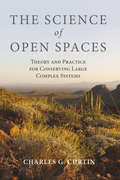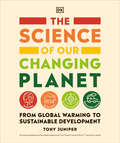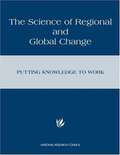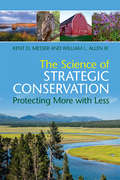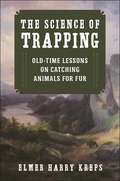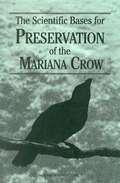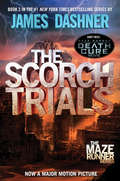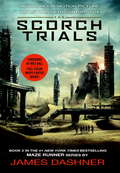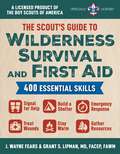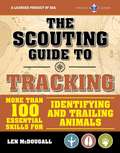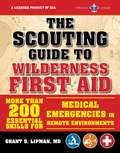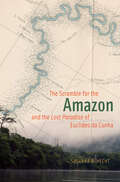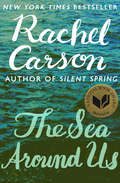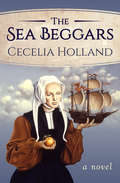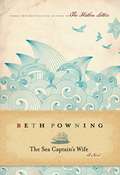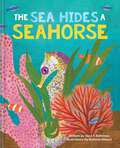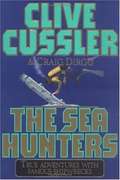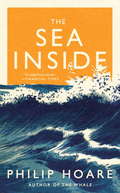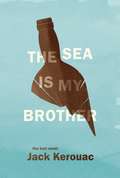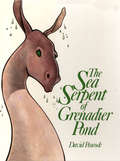- Table View
- List View
The Science of Open Spaces: Theory and Practice for Conserving Large, Complex Systems
by Charles G. CurtinFrom the days of the American Frontier, the term "open spaces" has evoked a vision of unspoiled landscapes stretching endlessly toward the horizon, of nature operating on its own terms without significant human interference. Ever since, government agencies, academia, and conservation organizations have promoted policies that treat large, complex systems with a one-size-fits-all mentality that fails to account for equally complex social dimensions of humans on the landscape. This is wrong, argues landscape ecologist and researcher Charles Curtin. We need a science-based approach that tells us how to think about our large landscapes and open spaces at temporally and spatially appropriate scales in a way that allows local landowners and other stakeholders a say in their futures. The Science of Open Spaces turns conventional conservation paradigms on their heads, proposing that in thinking about complex natural systems, whether the arid spaces of the southwestern United States or open seas shared by multiple nations, we must go back to "first principles"--those fundamental physical laws of the universe--and build innovative conservation from the ground up based on theory and backed up by practical experience. Curtin walks us through such foundational science concepts as thermodynamics, ecology, sociology, and resilience theory, applying them to real-world examples from years he has spent designing large-scale, place-based collaborative research programs in the United States and around the world. Compelling for not only theorists and students, but also practitioners, agency personnel, and lay readers, this book offers a thoughtful and radical departure from business-as-usual management of Earth's dwindling wide-open spaces.
The Science of Our Changing Planet: From Global Warming to Sustainable Development
by Tony JuniperLet&’s learn about climate change, how humans affect the planet, and sustainable development!Humans have had a great impact on the planet — and this science book takes a look at just how we&’ve changed the planet and what we can do to soften our impact. Understand the science that explains what pressure Earth is under, and how to take action!The Science of our Changing Planet explores how we can live more sustainably, and offers positive ideas on how we can alleviate past and present damage to the Earth. Inside, you&’ll find: • Wide-ranging coverage of problems affecting the planet, from global warming to pollution and food shortage. • Clear graphics that interpret and present the data in an easy-to-digest way. • Positive messages and plans for creating a better world, including the rise of clean/green technology. Written by environmentalist and sustainability advisor Dr. Tony Juniper, this eye-opening global warming book explains a wide range of research that captures the influence of human activities on our planet. Through powerful, easy-to-grasp graphics, this educational book gets straight to the facts! Discover the science behind climate change, overpopulation, overconsumption, pandemics and other factors that threaten life on Earth.The climate change book sheds light on how we&’re rapidly approaching the point of no return, but offers ideas on environmental conservation and how to use green technology to save the planet. Topics covered include problems like rising sea levels, shrinking Arctic ice sheets, plastic pollution, coastal flooding and threats to marine life. The biggest takeaway that Dr. Juniper offers is that living more sustainably and implementing new global goals will restore the future of our planet.
The Science of Regional and Global Change: PUTTING KNOWLEDGE TO WORK
by National Research CouncilThis report is intended to promote a dialogue between the scientific community and the government officials who will lead our nation in the coming years on global change research. The first section of the report is a brief description of the challenges and proposed responses needed from the highest levels of the government and the second provides more detailed discussion and is directed to agency-level issues and responses. The last section is a detailed bibliography that lists many of the specific reports on which the views outlined here are ultimately based.
The Science of Strategic Conservation: Protecting More With Less
by Kent D. Messer William L. Allen IIIBillions have been spent on land conservation but too little attention had been paid to how cost-effective these investments have been. With budgets increasingly constrained, conservationists must learn to fully harness their funds to protect critical resources. Messer and Allen are pioneers in making conservation selection more successful, cost-effective, scientific, and transparent. <P><P>This book introduces powerful mathematical tools available for project selection, using real-life examples and a practical step-by-step approach. Readers can readily apply these methods to their own work, accomplishing more with less by combining the individual benefits of structured decision-making, mathematical programming, and an understanding of market forces and human behavior. The authors highlight tools from conservation science, mathematics, land use planning and behavioral economics, showing how they can be combined to help protect key environmental resources. This is an invaluable volume for all students, professionals and stakeholders associated with conservation programs.<P> Offers a new approach to the topic of conservation finance, helping readers make better use of the funds they have rather than suggesting how they can increase funds,<P> Takes readers step by step through the process of strategic conservation, helping them gain familiarity with mathematical and market-based approaches.<P> Thirty days free access to LSPweb and ODST web programs allows readers to practice the techniques whilst reading the book and experience first hand how tools can benefit conservation efforts.
The Science of Trapping: Old-Time Lessons on Catching Animals for Fur
by Harry Elmer Kreps Phillip Massaro"Trapping in itself is an art.” -Elmer Harry KrepsIn recent years, the fur trade has experienced a rebirth as nations such as Russia and China demand more and more of these fine pelts. Answering this demand is a growing contingent of modern-day trappers, poised to reap the rewards of this economic boom. While many have the niftiest gadgets and tools at their disposal when capturing animals, others still use time-tested trapping techniques.Such techniques originated and were perfected in the woods of North America. Counted among this previous generation of trappers is Elmer Harry Kreps, a man who grew up in the woods of the Northeast, where he fostered a great passion for nature and its life. Spending countless hours observing these creatures, he quickly learned to trap them. He collected his lessons into the now classic The Science of Trapping, an immensely useful book on the trade of capturing animals for fur.The Science of Trapping describes methods to capture various kinds of animals in both warm and cold months; skunk, fox, bear, mink, and the shy lynx are all covered, among others. Keps ends with a review of the various kinds of traps popular during his day. Interspersed throughout this helpful volume is a unique glimpse into the fur economy of the early twentieth century.Skyhorse Publishing is proud to publish a broad range of books for hunters and firearms enthusiasts. We publish books about shotguns, rifles, handguns, target shooting, gun collecting, self-defense, archery, ammunition, knives, gunsmithing, gun repair, and wilderness survival. We publish books on deer hunting, big game hunting, small game hunting, wing shooting, turkey hunting, deer stands, duck blinds, bowhunting, wing shooting, hunting dogs, and more. While not every title we publish becomes a New York Times bestseller or a national bestseller, we are committed to publishing books on subjects that are sometimes overlooked by other publishers and to authors whose work might not otherwise find a home.
The Scientific Bases for Preservation of the Mariana Crow
by Committee on the Scientific Bases for the Preservation of the Mariana CrowThis book, while focusing on current preservation challenges posed by the Aga, or Mariana crow, also reflects the larger issues and challenges of biodiversity conservation in all oceanic island ecosystems. It evaluates causes for the continuing decline of the Aga, which exists on only the two southernmost islands in the Mariana archipelago, Guam and Rota, and reviews actions to halt or reverse the decrease.This book reminds us of the importance and challenge of preserving the unique environmental heritage of islands of the Mariana archipelago, the need for increased knowledge to restore and maintain native species and habitats, and the compelling and lasting value of extensive public education to stimulate environmentally informed public policy development.
The Scorch Trials (The Maze Runner #2)
by James DashnerSolving the Maze was supposed to be the end. No more puzzles. No more variables. And no more running. Thomas was sure that escape meant he and the Gladers would get their lives back. But no one really knew what sort of life they were going back to. In the Maze, life was easy. They had food, and shelter, and safety . . . until Teresa triggered the end. In the world outside the Maze, however, the end was triggered long ago. Burned by sun flares and baked by a new, brutal climate, the earth is a wasteland. Government has disintegrated--and with it, order--and now Cranks, people covered in festering wounds and driven to murderous insanity by the infectious disease known as the Flare, roam the crumbling cities hunting for their next victim . . . and meal. The Gladers are far from finished with running. Instead of freedom, they find themselves faced with another trial. They must cross the Scorch, the most burned-out section of the world, and arrive at a safe haven in two weeks. And WICKED has made sure to adjust the variables and stack the odds against them. Thomas can only wonder--does he hold the secret of freedom somewhere in his mind? Or will he forever be at the mercy of WICKED?
The Scorch Trials (The Maze Runner #2)
by James DashnerRead the second book in the #1 New York Times bestselling Maze Runner series that is soon to be a motion picture, hitting theaters September 18, 2015, and is perfect for fans of The Hunger Games and Divergent. This special movie tie-in edition features an eight-page full-color insert with photos from the film. The first book, The Maze Runner, is now a movie featuring the star of MTV's Teen Wolf, Dylan O'Brien; Kaya Scodelario; Aml Ameen; Will Poulter; and Thomas Brodie-Sangster! Also look for James Dashner's newest series: the Mortality Doctrine that includes The Eye of Minds and The Rule of Thoughts.Solving the Maze was supposed to be the end.Thomas was sure that escape from the Maze would mean freedom for him and the Gladers. But WICKED isn't done yet. Phase Two has just begun. The Scorch.There are no rules. There is no help. You either make it or you die.The Gladers have two weeks to cross through the Scorch--the most burned-out section of the world. And WICKED has made sure to adjust the variables and stack the odds against them.Friendships will be tested. Loyalties will be broken. All bets are off.There are others now. Their survival depends on the Gladers' destruction--and they're determined to survive.Praise for the Maze Runner series:A #1 New York Times Bestselling SeriesA USA Today BestsellerA Book Sense BestsellerAn Indie Next List SelectionA Kirkus Reviews Best Teen Book of the YearAn ALA-YASLA Best Fiction for Young Adults BookAn ALA-YALSA Quick Pick"[A] mysterious survival saga that passionate fans describe as a fusion of Lord of the Flies, The Hunger Games, and Lost."-EW.com"Wonderful action writing--fast-paced...but smart and well observed."-Newsday"[A] nail-biting must-read."-Seventeen.com"Breathless, cinematic action."-Publishers Weekly"Heart-pounding to the very last moment."-Kirkus Reviews"Exclamation-worthy."-Romantic Times[STAR] "James Dashner's illuminating prequel [The Kill Order] will thrill fans of this Maze Runner [series] and prove just as exciting for readers new to the series."-Shelf Awareness, Starred
The Scout's Guide to Wilderness Survival and First Aid: 400 Essential Skills—Signal for Help, Build a Shelter, Emergency Response, Treat Wounds, Stay Warm, Gather Resources
by Grant S. Lipman J. Wayne Fears2 books in 1 at a value price! Be Prepared! Time-tested advice on emergency preparedness. An official publication of the Boy Scouts of America! Each year hundreds of outdoor enthusiasts find themselves in an unexpected outdoor emergency. They get lost, injured, or stranded. Cut off from the rest of the world, they have to depend upon their survival skills to survive. For most people, thanks to modern communications such as cell phones, satellite messengers, and personal locator beacons (PLB), it is merely a sobering two- or three-hour adventure. However, for some who did not take the proper precautions before they left home or do not have survival skills, it can end in tragedy.The Scout's Handbook for Wilderness Survival and First Aid offers practical advice to help with: Building a firePurifying waterIdentifying common edible plants and mushroomsSignaling for helpBuilding simple sheltersPractical navigation skillsTreating woundsResponding in a medical emergencyAnd so much more! Since 1910, the Boy Scouts of America has helped build the future leaders of this country by combining educational activities and lifelong values with fun. The BSA is committed to training youth in responsible citizenship, character development, and self-reliance through participation in a wide range of outdoor activities.
The Scouting Guide to Survival: More than 200 Essential Skills for Staying Warm, Building a Shelter, and Signaling for Help (BSA Scouting Guides)
by J. Wayne FearsIn Scouting’s Guide to Survival, current Scouts, Scout alumni, and readers interested in the outdoors are provided with time-tested advice on emergency preparedness. Some practical tips include: How to build a fire How to purify water How to identify common edible plants and mushrooms How to signal for help How to build simple shelters Learn practical navigation skills And so much more! Since 1910, the Boy Scouts of America has helped build the future leaders of this country by combining educational activities and lifelong values with fun. The BSA is committed to training youth in responsible citizenship, character development, and self-reliance through participation in a wide range of outdoor activities.
The Scouting Guide to Tracking: Essential Skills for Identifying and Trailing Animals
by Len McDougall The Boy Scouts of AmericaIn Scouting&’s Guide to Tracking, current Scouts, Scout alumni, and readers interested in the outdoors are provided with time-tested advice on how to track big and small animals over different types of terrain. Some practical tips include: How to determine the age of tracks in any circumstanceHow to recognize the distinctive marks of dozens of different speciesHow to track in desert, forest, snow, and grassy areasHow to identify instances when an animal has circled around or backtrackedStalking techniques such as cold hunting, camouflaging, and using the stump methodHow time and weather affect signsAnd so much more! Since 1910, the Boy Scouts of America has helped build the future leaders of this country by combining educational activities and lifelong values with fun. The BSA is committed to training youth in responsible citizenship, character development, and self-reliance through participation in a wide range of outdoor activities.
The Scouting Guide to Wilderness First Aid: More than 200 Essential Skills for Medical Emergencies in Remote Environments
by Grant S. Lipman The Boy Scouts of AmericaIn the Scouting Guide to Wilderness First Aid, current Scouts, Scout alumni, and readers interested in the outdoors are provided with time-tested advice on how to safely identify, harvest, and use edible wild plants. Some practical tips include: How to triage, assess, and identify medical emergenciesWhat to include in a first aid kit for your homeWhen to seek help for health emergenciesHow to safely move a sick or injured personHow to perform CPR and use an automatic external defibrillatorWhat the proper procedures are for broken bones, hypothermia, burns, and sprainsAnd so much more!Since 1910, the Boy Scouts of America has helped build the future leaders of this country by combining educational activities and lifelong values with fun. The BSA is committed to training youth in responsible citizenship, character development, and self-reliance through participation in a wide range of outdoor activities.
The Scramble for the Amazon and the Lost Paradise of Euclides da Cunha
by Susanna B. HechtA “compelling and elegantly written” history of the fight for the Amazon basin and the work of a brilliant but overlooked Brazilian intellectual (Times Literary Supplement, UK).The fortunes of the late nineteenth century’s imperial powers depended on a single raw material—rubber—with only one source: the Amazon basin. This scenario ignited a decades-long conflict that found Britain, France, Belgium, and the United States fighting with and against the new nations of Peru, Bolivia, and Brazil for the forest’s riches. In the midst of this struggle, the Brazilian author and geographer Euclides da Cunha led a survey expedition to the farthest reaches of the river. The Scramble for the Amazon tells the story of da Cunha’s terrifying journey, the unfinished novel born from it, and the global strife that formed the backdrop for both. Haunted by his broken marriage, da Cunha trekked through a beautiful region thrown into chaos by guerrilla warfare, starving migrants, and native slavery. All the while, he worked on his masterpiece, a nationalist synthesis of geography, philosophy, biology, and journalism entitled Lost Paradise. Hoping to unveil the Amazon’s explorers, spies, natives, and brutal geopolitics, Da Cunha was killed by his wife’s lover before he could complete his epic work. once the biography of Da Cunha, a translation of his unfinished work, and a chronicle of the social, political, and environmental history of the Amazon, The Scramble for the Amazon is a work of thrilling intellectual ambition.
The Sea Around Us
by Rachel CarsonNational Book Award Winner and New York Times Bestseller: Explore earth&’s most precious, mysterious resource—the ocean—with the author of Silent Spring. With more than one million copies sold, Rachel Carson&’s The Sea Around Us became a cultural phenomenon when first published in 1951 and cemented Carson&’s status as the preeminent natural history writer of her time. Her inspiring, intimate writing plumbs the depths of an enigmatic world—a place of hidden lands, islands newly risen from the earth&’s crust, fish that pour through the water, and the unyielding, epic battle for survival. Firmly based in the scientific discoveries of the time, The Sea Around Us masterfully presents Carson&’s commitment to a healthy planet and a fully realized sense of wonder. This ebook features an illustrated biography of Rachel Carson including rare photos and never-before-seen documents from the Beinecke Rare Book and Manuscript Library at Yale University.
The Sea Beggars: A Novel
by Cecelia HollandA sixteenth-century family joins with pirates and William of Orange to fight the Spanish Inquisition in this novel of the Dutch Revolt by &“a first-class storyteller&” (People). Consistently ranked among the top authors of historical fiction, along with Mary Renault, Mary Stewart, Phillipa Gregory, and Diana Gabaldon, the great Cecelia Holland now transports readers to the sixteenth-century Netherlands in an exciting tale of resistance and rebellion against cruel Spanish oppressors that combines unforgettable fictional characters with real historic personages. No one was safe from religious persecution in the Dutch Low Countries when the &“conqueror king,&” Phillip II of Spain, dispatched the Catholic Church&’s Inquisition to the Netherlands in the late 1500s. The van Cleef family has suffered mightily, with a father executed by a Spanish hangman and a mother driven into madness. Now their children, Jan and Hanneke, must survive on their own by any means necessary as fate carries them down separate but equally dangerous paths. Jan&’s destiny is on the high seas—and ultimately in the royal court of England&’s Queen Elizabeth—as he and his uncle Pieter boldly retake the old man&’s captive ship and join the infamous pirates known as the Sea Beggars in their quest to drive the enemy invaders from Dutch waters. Remaining behind in Antwerp, Hanneke, meanwhile, is forced to endure a series of devastating trials that would crush a young woman of weaker spirit and sensibilities. Strong, courageous, and independent, she embarks on a harrowing journey to Germany in the company of refugee ruler William of Orange ahead of the impending terror of Spain&’s sadistic Duke of Alva. But young Hanneke soon realizes there can be no escape or safe haven anywhere as long as her country is in chains, and she vows to dedicate her life to the perilous cause of freedom. A sweeping and epic historical novel rich in color and stunning period detail, Holland&’s The Sea Beggars is an enthralling, action-packed adventure that interweaves fact with brilliant invention. It is yet one more fictional excursion into the breathtaking world of the past by an author the New York Times praises as &“a literary phenomenon.&”
The Sea Book (Conservation for Kids)
by Charlotte MilnerFeaturing fascinating, fishy fun facts accompanied by bright, bold, and beautiful illustrations, this ebook takes children on a journey through the sea and all its zones. This charming celebration of the sea shows children how extraordinary our oceans are and is a reminder that it is up to us to keep it that way. The Sea Book is the coolest educational ebook about the sea, covering a wealth of sea animals, including mammals, fish, invertebrates, and reptiles. It explores the underwater worlds of incredible marine life and their habitats. From up on the ice, down to colorful coral reefs, underwater forests, and right down to the deepest darkest depths where the weird and wonderful lurk - it's sure to delight any ocean obsessed child.Following on from The Bee Book, Charlotte Milner continues to highlight critical environmental issues faced by our planet. This time the focus is on our watery friends and the damaging effects humans are having on our seas. The perfect introduction to ocean conservation packaged in a way that won't leave children (or their parents for that matter) fearing for life on earth. Children will discover what they can do to help, and there are fantastic tips on how to live plastic-free as well. Kids will also get to craft their own recycled shopping bag too!Dive Into A Watery WorldWhat lies beneath the waves?Life can be found everywhere in the sea - from the sunlit ocean surface to the darkest depths. The sea is home to a variety of life, which makes it a fascinating, exciting, and significant place. There are more than 33 000 types of fish. Some fish can fly, some can dance, some are flat, and some are long. The sea has forests, ice, and exciting critters too. This adorable kid's ebook is the perfect meet-cute for kids and our beautiful oceans. Discover our oceans in a whole new way, learning about:- Why the see is important- What lies beneath the waves- Life on the ice- Changing seas and plastic problems- How you can help and much, much more!This delightful book is one of three children's books on conservation for your little ones to enjoy. Try The Bat Book and The Bee Book next!
The Sea Captain's Wife
by Beth PowningAzuba Galloway, daughter of a shipwright, sees ships leaving for foreign ports from her bustling town on the Bay of Fundy and dreams of seeing the world. When she marries Nathaniel Bradstock, a veteran sea captain, she believes she will sail at his side. But when she becomes pregnant she is forced to stay behind. Her father has built the couple a gabled house overlooking the bay, but the gift cannot shelter her from the loneliness of living without her husband. When Azuba becomes embroiled in scandal, Nathaniel is forced to take her and their daughter, Carrie, aboard his ship. They set sail for London with bitter hearts. Their voyage is ill-fated, beset with ferocious storms and unforeseen obstacles that test Azuba's compassion, courage and love. Alone in a male world, surrounded by the splendour and the terror of the open seas, she must face her fears and fight to keep her family together.
The Sea Captain's Wife: A Novel
by Beth PowningGrowing up on the Bay of Fundy, Azuba Galloway dreams of going to sea. She watches magnificent ships slowly making their way into Whelan’s Cove, the sense of exoticism bursting from their holds along with foreign goods. As a young woman, Azuba marries a seasoned merchant sea captain, Nathaniel Bradstock. Unwilling to have him away at sea for most of their married life, and anxious to see far shores, she extracts a promise that he will take her with him. But Azuba becomes pregnant soon after they marry and Nathaniel knows too well the perils of life on a ship. He reneges on his promise and refuses to allow Azuba to join him. When Nathaniel leaves on his journey, Azuba desperately misses her husband. Days turn into weeks and months – voyages can take two, three years before the ship and crew return home. Despite her loneliness, Azuba becomes a strong, independent woman, caring for her child and her home. With her parents and beloved grandmother nearby, she settles into a life of quietude and predictability, all the while yearning to be by her husband’s side aboard his ship. Her loneliness eventually propels her into a friendship with the local vicar, Reverend Simon Walton. He is a quiet, kind and contemplative man, and Azuba takes comfort and enjoyment in their increasingly intimate friendship. One afternoon, despite her misgivings, Azuba goes on a picnic with the vicar and becomes trapped by the tide. When they return home the next morning, Azuba and Reverend Walton have become a topic of gossip. When Nathaniel returns home he is enraged by her impropriety. Reluctantly he decides to take Azuba and their young daughter, Carrie, with him on his next voyage. Mother and child are loaded from a rowboat and hauled onto the weather deck along with barrels of coal and crates of chickens. Nathaniel has drawn a line across the deck. “You’ll never again cross that line,” he instructs Azuba.It is October 1862. It will be three years before Azuba sees the shores of Whelan’s Cove again. Aboard Traveller, the small family visits places Azuba dreamed she would one day see: London, San Francisco and exotic countries in Europe. But she also experiences the terror that can come during a life at sea: a harrowing passage around Cape Horn, half-starvation while listlessly floating in the doldrums, and a stop at the Chincha Islands to pick up a load of guano, where she witnesses a mass suicide by slaves. She begins to question her decision to join her husband, particularly when she realizes there is “no way to erase horror from a child’s memory.”Misery follows misfortune and Azuba feels alone in a male world, surrounded by the splendour and the terror of the open sea. The voyage tests not only her already precarious marriage, but everything Azuba believes in. With a sure hand, Beth Powning captures life aboard a sailing ship – ferocious storms, the impossibly isolated ports of call, the gruelling daily routine – and shows how love evolves even in the most extreme circumstances. The Sea Captain’s Wife is an awe-inspiring tour that captures the vigour of life in the last days of the Age of Sail and gives us an unforgettable young heroine who shows compassion, courage and love while under incredible duress.
The Sea Hides a Seahorse
by Sara T. BehrmanIn lyrical prose with beautifully rendered illustrations, this gorgeous picture book introduces young readers to the amazing world of seahorses."This saltwater standout will have librarians, parents, and mini marine biologists hooked." —School Library Journal, starred review Hidden in the ocean of colorful fish, octopus, kelp, sea sponges, and other sea life is a most unique creature: the seahorse. Featuring different species of seahorses and seadragons across the world, The Sea Hides a Seahorse is a subtle seek-and-find story that journeys underwater to provide a glimpse into the secrets of seahorses as they swim, hide, hunt, court, mate, and more. Included at the back is more information about seahorses and how to support their protection and conservation.
The Sea Hunters I: True Adventures with Famous Shipwrecks
by Clive CusslerA nonfiction work by the creator of Dirk Pitt, this book tells thirteen tales of searches for shipwrecks. The circumstances surrounding each are described in detail along with the searches. This book reads like a novel. Among the shipwrecks are the C.S.S. Hunley, a confederate submarine-- the first to sink a ship in battle, The Leopoldville, a troop transport torpedoed by a German U-boat on Christmas eve, 1944 and the discovery of U-20, the German sub that sank the Lusitania in 1915.
The Sea Inside
by Philip HoareA yearlong adventure through the world's oceans with Philip Hoare, the award-winning author of The WhaleIn colorful prose and lively line drawings, Hoare sets out to rediscover the sea and its islands, birds, and beasts. Starting at his home on the shores of Britain's Southampton Water and moving in ever widening circles--like the migration patterns of whales--Hoare explores London, the Isle of Wight, the Azores, Sri Lanka, Tasmania, and New Zealand.As Hoare brilliantly weaves together literary and natural history, we encounter memorable people as well as the dolphins, whales, and other creatures above and below the water (even one species formerly believed to be extinct).Echoing the fine tradition of W. G. Sebald, but in a voice all Hoare's own, The Sea Inside is bursting with an endless series of delights and revelations from the ever-changing sea.
The Sea Is My Brother
by Jack KerouacIn the spring of 1943, during a stint in the Merchant Marine, twenty-one-year old Jack Kerouac set out to write his first novel. Working diligently day and night to complete it by hand, he titled it The Sea Is My Brother. Now, nearly seventy years later, its long-awaited publication provides fascinating details and insight into the early life and development of an American literary icon. Written seven years before The Town and The City officially launched his writing career, The Sea Is My Brother marks a pivotal point in which Kerouac began laying the foundations for his pioneering method and signature style. A clear precursor to such landmark works as On the Road, The Dharma Bums, and Visions of Cody, it is an important formative work that bears all the hallmarks of classic Kerouac: the search for spiritual meaning in a materialistic world, spontaneous travel as the true road to freedom, late nights in bars and apartments engaged in intense conversation, the desperate urge to escape from society, and the strange, terrible beauty of loneliness.
The Sea Otter (Endangered in America)
by Alvin Silverstein Virginia Silverstein Robert SilversteinThese graceful creatures never leave the water, not even to give birth. Their warm fur, helps to keep them warm and also to float, and they have almost human like paws. Come and learn more about the "teddy bear of the sea" the sea otter. Find out what these marvelous creatures eat, how they groom themselves, how they mate and what efforts have been made to protect these valuable creatures from extinction. includes an index and further reading suggestions. Grades 3 and up. Other books in this series are also available from Bookshare. This file should make an excellent embossed braille copy.
The Sea Serpent of Grenadier Pond
by David PeacockThis is a children’s book about the the sea serpent of Grenadier Pond.
The Sea Shall Not Have Them (The WWII Naval Thrillers)
by Max HennessyThe &“supremely well told&” classic war novel of espionage in the most extreme of situations—from the acclaimed author of Ride Out the Storm (Evening Standard). An essential flight from France crash lands in the North Sea, leaving the four remaining crew members of the RAF Hudson stranded on a dinghy. One man is critically injured, and another, a rocket expert, is carrying a briefcase stuffed with vital war secrets, that could prove devastating if allowed to fall into the wrong hands. As the days begin to stretch out, they can only pray that the rescue team can locate the dinghy in time, before exposure kills them, or worse, the enemy finds them . . . A novel which charts the daring and courage of four castaways, and the men who rescued them in a breathtaking mission with the most awesome of consequences, perfect for fans of Alexander Fullerton, David McDine, and Alan Evans.
